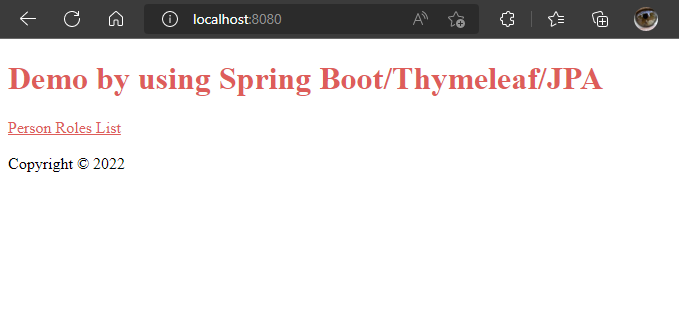项目源码寄存在Github repo
继上一篇 《Step by Step Tutorial for Spring Boot and Thymeleaf: Part I》 介绍了项目的初始环境,还有对应的Model,以及对应的Repository之后,这一篇开始涉及具体的Controller和View————这些还是基于MVC概念。
官方文档
官方Thymeleaf 与Spring Boot的文档:Thymeleaf Doc
列表页面
列表页面所有的Person Role。
Controller
这里的Controller其实支持了多个View。这里的两个method:
- index: 主页面 (对应于URL: localhost:8080) ;
- getPersonRoles: 显示Person Role列表 (对应于URL: localhost:8080/personroles);
import java.util.List;
import org.slf4j.Logger;
import org.slf4j.LoggerFactory;
import org.springframework.beans.factory.annotation.Autowired;
import org.springframework.beans.factory.annotation.Value;
import org.springframework.stereotype.Controller;
import org.springframework.ui.Model;
import org.springframework.web.bind.annotation.GetMapping;
import org.springframework.web.bind.annotation.ModelAttribute;
import org.springframework.web.bind.annotation.PathVariable;
import org.springframework.web.bind.annotation.PostMapping;
import org.springframework.web.bind.annotation.RequestParam;
import com.alvachien.springtutorial.thymeleafjpademo.exception.ResourceNotFoundException;
import com.alvachien.springtutorial.thymeleafjpademo.model.PersonRole;
import com.alvachien.springtutorial.thymeleafjpademo.service.PersonRoleService;
@Controller
public class PersonRoleController {
private final Logger logger = LoggerFactory.getLogger(this.getClass());
private final int ROW_PER_PAGE = 5;
@Autowired
private PersonRoleService personRoleService;
@Value("${msg.title}")
private String title;
@GetMapping(value = {"/", "/index"})
public String index(Model model) {
model.addAttribute("title", title);
return "index";
}
@GetMapping(value = "/personroles")
public String getPersonRoles(Model model, @RequestParam(value = "page", defaultValue = "1") int pageNumber)
{
List<PersonRole> roles = personRoleService.findAll(pageNumber, ROW_PER_PAGE);
long count = personRoleService.count();
boolean hasPrev = pageNumber > 1;
boolean hasNext = (pageNumber * ROW_PER_PAGE) < count;
model.addAttribute("roles", roles);
model.addAttribute("hasPrev", hasPrev);
model.addAttribute("prev", pageNumber - 1);
model.addAttribute("hasNext", hasNext);
model.addAttribute("next", pageNumber + 1);
return "person-role-list";
}
}
View
Thymeleaf的语法大致规律如下:
- 需要在HTML的tag下设置对应XML的namespace:
xmlns:th="http://www.thymeleaf.org" - 设置HTML中Tag的
th属性:th:text:设置当前元素的文本内容;th:utext:设置文本内容。与th:text的区别在于,th:text不会转义html标签,而th:utext会。th:value:设置当前元素的value值,类似修改指定属性的还有th:src,th:href。th:href:设置超链接。th:each:遍历循环元素,通常和th:text或th:value一起使用。th:if:条件判断,类似的还有th:unless,th:switch,th:case。th:insert:代码块。类似的还有th:replace,th:include,三者的区别较大,若使用不恰当会破坏html结构,常用于公共代码块提取的场景。th:fragment:定义代码块,方便被th:insert引用。th:object:声明变量,一般和*{}一起配合使用。th:attr:修改任意属性,类似的还有th:attrappend,th:attrprepend。
- 表达式语法
${...}:变量表达式,通常跟th:text联动;<span th:text="${role.name}">*{...}:选择表达式,它类似于变量表达式,但是它读取一个预先选择的对象,通常跟th:object跟th:text联用。 ```html
- `#{...}`: 消息/文字表达式,允许读取文字信息。 ```html <div th:text="#[message.name]"></div>@{...}:链接url表达式,把一个有用的上下文或回话信息添加到URL;<a th:href="@{/main}">Back to index</a>~{...}:代码块表达式;
主页(index.html)
对应的模板文件如下:
<html xmlns:th="http://www.thymeleaf.org">
<head>
<meta charset="UTF-8" />
<title th:utext="${title}" />
</head>
<body>
<h1 th:utext="${title}" />
<a th:href="@{/personroles}">Person Roles List</a>
</body>
</html>
List页面 (person-role-list.html)
对应的模板文件如下:
<html xmlns:th="http://www.thymeleaf.org">
<head>
<meta charset="UTF-8" />
<title>Person Role List</title>
</head>
<body>
<h1>Person Role List</h1>
<div>
<nobr>
<a th:href="@{/}">Back to Index</a>
</nobr>
</div>
<br/><br/>
<div>
<table border="1">
<tr>
<th>Id</th>
<th>Name</th>
<th>Value</th>
<th></th>
</tr>
<tr th:each ="role : ${roles}">
<td><a th:href="@{/personroles/{roleId}(roleId=${role.getId()})}" th:utext="${role.getId()}">...</a></td>
<td><a th:href="@{/personroles/{roleId}(roleId=${role.getId()})}" th:utext="${role.getRoleName()}">...</a></td>
<td th:utext="${role.getRoleValue()}">...</td>
<td><a th:href="@{/personroles/{roleId}/edit(roleId=${role.getId()})}">Edit</a></td>
</tr>
</table>
</div>
<br/><br/>
<div>
<nobr>
<span th:if="${hasPrev}"><a th:href="@{/personroles?page={prev}(prev=${prev})}">Prev</a> </span>
<span th:if="${hasNext}"><a th:href="@{/personroles?page={next}(next=${next})}">Next</a></span>
</nobr>
</div>
</body>
</html>
运行程序:

